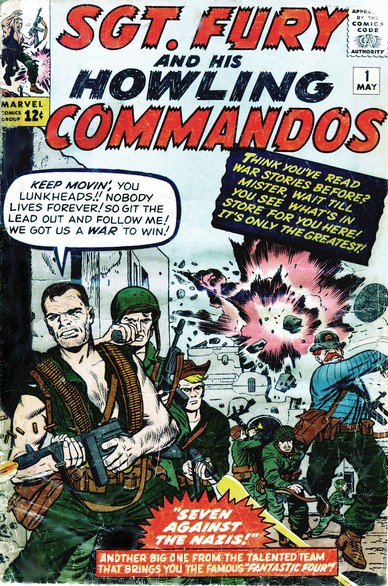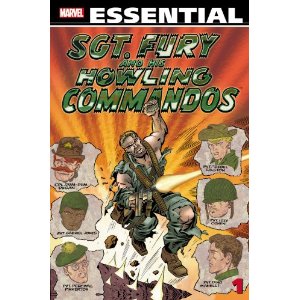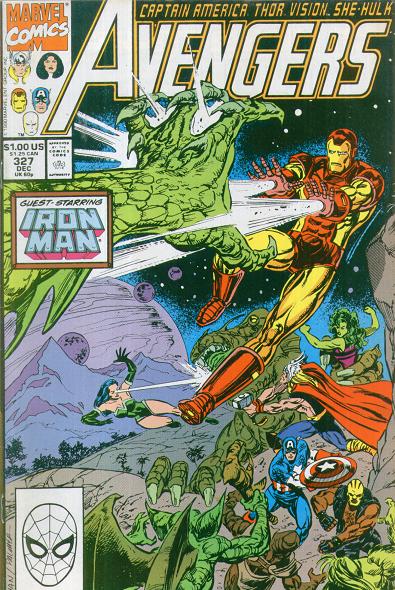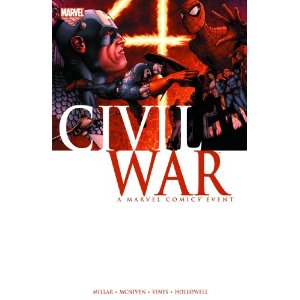With Black Widow and Hawkeye accounted for, our Avengers assembly is only awaiting one major cast member: Nick Fury. Although Fury is a S.H.I.E.L.D. agent rather than an Avenger, in the movie he is tasked with running the Avengers initiative, effectively making the Avengers assets of S.H.I.E.L.D. under Fury’s command. This is a different account of the Avengers’ origins than the original comic book, but it represents a natural development of the ongoing back-story of the relationship between the Avengers and S.H.I.E.L.D.
From World War II Hero to Director of S.H.I.E.L.D.
Nick Fury’s adventures were initially set during World War II when he was first introduced in Sgt. Fury and His Howling Commandos #1 in May 1963. Here Fury led a racially integrated unit on raids against the Axis.


[Howling Commandos interiors courtesy of the collection of Barry Pearl–thanks, Barry!]
Essential Sgt. Fury – Volume 1 (Essential (Marvel Comics))
Stan Lee soon began writing Fury into the contemporary Marvel continuity by having him cross paths with the wartime predecessors of the Cold War intelligence community and with future Silver Age superheroes. Issue #3 (September 1963) saw Fury encountering a wartime Reed Richards, portrayed as an agent of the Office of Strategic Services (OSS), the World War II prototype for the CIA. In issue #13 (December 1964), Fury fought side by side with the wartime Captain America and Bucky. By this time Cap had joined the Avengers.
Meanwhile the James Bond craze had reached its peak with the release of the third Connery Bond movie Goldfinger in 1964. Bond author Ian Fleming was recruited to contribute to the development of an espionage TV show called The Man from U.N.C.L.E., describing the adventures of a fictional international law enforcement agency called the United Network Command for Law and Enforcement.
In August 1965 Strange Tales #135 upgraded Nick Fury to Colonel and assigned him to work for S.H.I.E.L.D.: the Supreme Headquarters, International Espionage, Law-Enforcement Division. The acronym drew inspiration from U.N.C.L.E. as well as from the real-life NATO military command SHAPE (Supreme Headquarters Allied Powers Europe).
Another inspiration for the name and other aspects of the concept was Fleming’s fictional terrorist organization S.P.E.C.T.R.E. (Special Executive for Counter-intelligence, Terrorism, Revenge, and Extortion). S.P.E.C.T.R.E. was a syndicate formed by former Nazi Gestapo officers, Soviet assassins, the Mafia, the French mob, Yugoslavian secret police, and Turkish heroin smugglers. As Bond battled S.P.E.C.T.R.E., Fury and S.H.I.E.L.D. fought a Nazi-descended terrorist organization called HYDRA (which is apparently not an abbreviation for anything).
S.H.I.E.L.D. was initially formed to fight HYDRA. After HYDRA assassinated the first Director of the organization (a title modeled on that of famed CIA Director Allen Dulles), Fury was promoted to Director of S.H.I.E.L.D.
S.H.I.E.L.D. and the Avengers
When Fury first joined S.H.I.E.L.D., he learned that its Special Weaponry Section was run by Tony Stark, filling the role played by Q in the James Bond movies. Stark formed an early link between S.H.I.E.L.D. and the Avengers, effectively serving as an undercover S.H.I.E.L.D. asset during his initial stint on the Avengers, which lasted to Avengers #16 (May 1965). This plausibly deniable relationship grew over time into an official relationship.
The Avengers were initially a private group funded by Stark and led by other team members–first Ant-Man and Wasp, and later Captain America. As a career soldier and a veteran of numerous intelligence operations, Cap formed another link between the Avengers and the US government.
Another bond was formed when former Soviet spy Black Widow came over to work for the U.S. intelligence community. From Avengers #29 on (June 1966), Widow periodically entered into Avengers storylines. She went undercover for S.H.I.E.L.D. in Avengers #38, during an assignment which required her to decline membership in the Avengers at that time. Later, after completing her assignment successfully, she assisted the Avengers several times, and formally joined the team in #111 (May 1973).
S.H.I.E.L.D. and the Avengers teamed up to protect Earth from the alien Skrull menace during the Kree-Skrull War, a saga of events which began in Avengers #89 (June 1971) and lasted through #97 (March 1972). During the course of the war Iron Man rejoined the team.
The relationship between the Avengers and the U.S. government became formal after the National Security Agency (NSA) appointed an official U.S. Government Liaison to the Avengers, Henry Peter Gyrich (introduced in Avengers #165, November 1977). Gyrich, later identified as associated with the National Security Council (NSC), regarded the team as a threat to national security and sought to control their membership and activities. This created tension between the Avengers and S.H.I.E.L.D., expressed during a Senate showdown between a S.H.I.E.L.D. witness called by Gyrich and Captain America in Avengers #190. The Avengers win their case the next issue after Gyrich is forced to rely on them to stop the Grey Gargoyle, and Gyrich is replaced as Avengers liaison by Raymond Sikorski.
Sikorski negotiated the relationship between the US government and the Avengers through a series of crises that redefined the team’s relationship to the U.S. and S.H.I.E.L.D. A US disarmament treaty with the declining Soviet Union in Avengers #327 (December 1990) led to the revocation of the Avengers’ corporate charter and a reformation of the team under a charter issued by the United Nations. The U.N. Avengers expanded internationally, only to disband during the Avengers Disassembled story arc (2004-2005).
Meanwhile, S.H.I.E.L.D. had also been shaken up. Following 9/11, Nick Fury’s concerns about US security laxity prompted him to conduct an unauthorized mission against Latveria during the Secret War limited series (2004-2005), which led to his resignation as S.H.I.E.L.D. Director.
Fury’s replacement Maria Hill opposed the reformation of the Avengers following the House of M story arc (2005). Despite Hill, a New Avengers team formed that included Iron Man and Captain America.
The events of the Civil War story arc (2006-2007) culminated with Tony Stark replacing Hill as Director of S.H.I.E.L.D and Hill being demoted to Deputy Director. With S.H.I.E.L.D. authority, Iron Man reformed the original Avengers as an official government team, chronicled in The Mighty Avengers (2007-2010). S.H.I.E.L.D. and Stark’s Avengers were officially joined for a brief time until the events of the Secret Invasion (2008-2009) led the President to dissolve S.H.I.E.L.D. The Avengers now drifted under the control of Norman Osborn’s agency H.A.M.M.E.R. during the Dark Avengers saga (2009-2010). To counter H.A.M.M.E.R., Fury reformed S.H.I.E.L.D. with Daisy Johnson as Director, as told in the Secret Warriors series.
In 2010 the Avengers were rebooted, following the Seige story arc and the cancellation of all current Avengers titles. A new Avengers team was launched as part of Marvel’s Heroic Age rebranding, with Maria Hill as team leader. The relationship between S.H.I.E.L.D. and the Avengers was restored.
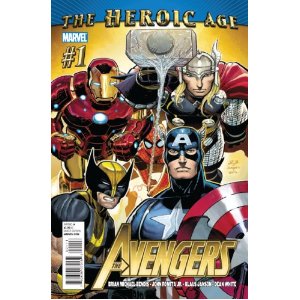
The Avengers #1 2010 The Heroic Age
Fury in Film
The S.H.I.E.L.D. relationship to the Avengers has been expanded into a new retelling of the team’s origins in films leading up to the current film. Appearances by Samuel L. Jackson as Nick Fury have served to link individual films together. Jackson first appeared after the credits in Iron Man (2008) to tell Robert Downey Jr.’s Tony Stark, “I’m here to talk to you about the Avenger Initiative.” Follow-up appearances by Downey in Hulk (2008) and by Jackson in Iron Man 2010, Thor (2011), and Captain America: The First Avenger (2011) set the stage for the stars of these individual films to join together in The Avengers. Marvel’s film universe has now made Nick Fury the new leader of the Avengers.
